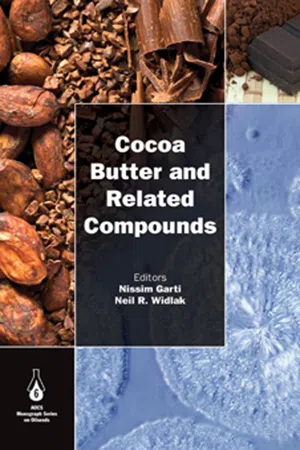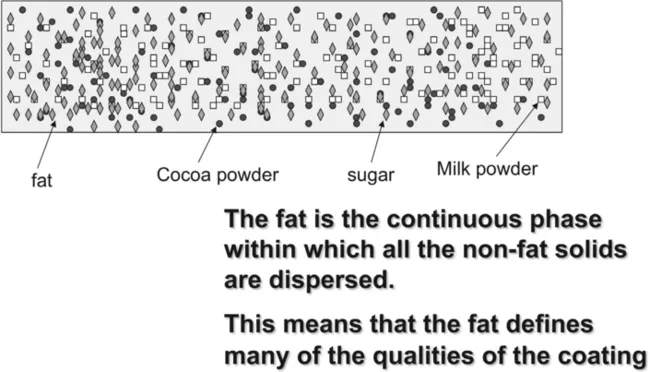
- 540 pages
- English
- ePUB (mobile friendly)
- Available on iOS & Android
eBook - ePub
Cocoa Butter and Related Compounds
About this book
This book covers the progress of the last 10 years of studies on cocoa butter. Descriptions of several aspects, including physical characteristics such as rheology, hardness, melt profiles, etc., studied by new and advanced techniques are included. Similarly, the polymorphism of cocoa butter is reconsidered in light of studies done by synchrotron DSC, FTIR, and SAXS techniques. These data are complemented by new understandings on the cause of the crystallization and transitions of the polymorphs. Other aspects such as the effect of minor components, emulsifiers, and other fats are discussed in great detail in this book.
- Brings together all that is known about cocoa butter into one book
- Describes physical characteristics of cocoa butter including rheology, hardness, and melt profiles
- Reconsiders polymorphism of cocoa butter in light of recent studies by various analytical techniques
- Presents new understandings on the cause of crystallization and transitions of polymorphs
Frequently asked questions
Yes, you can cancel anytime from the Subscription tab in your account settings on the Perlego website. Your subscription will stay active until the end of your current billing period. Learn how to cancel your subscription.
No, books cannot be downloaded as external files, such as PDFs, for use outside of Perlego. However, you can download books within the Perlego app for offline reading on mobile or tablet. Learn more here.
Perlego offers two plans: Essential and Complete
- Essential is ideal for learners and professionals who enjoy exploring a wide range of subjects. Access the Essential Library with 800,000+ trusted titles and best-sellers across business, personal growth, and the humanities. Includes unlimited reading time and Standard Read Aloud voice.
- Complete: Perfect for advanced learners and researchers needing full, unrestricted access. Unlock 1.4M+ books across hundreds of subjects, including academic and specialized titles. The Complete Plan also includes advanced features like Premium Read Aloud and Research Assistant.
We are an online textbook subscription service, where you can get access to an entire online library for less than the price of a single book per month. With over 1 million books across 1000+ topics, we’ve got you covered! Learn more here.
Look out for the read-aloud symbol on your next book to see if you can listen to it. The read-aloud tool reads text aloud for you, highlighting the text as it is being read. You can pause it, speed it up and slow it down. Learn more here.
Yes! You can use the Perlego app on both iOS or Android devices to read anytime, anywhere — even offline. Perfect for commutes or when you’re on the go.
Please note we cannot support devices running on iOS 13 and Android 7 or earlier. Learn more about using the app.
Please note we cannot support devices running on iOS 13 and Android 7 or earlier. Learn more about using the app.
Yes, you can access Cocoa Butter and Related Compounds by Nissim Garti,Neil R. Widlak in PDF and/or ePUB format, as well as other popular books in Physical Sciences & Analytic Chemistry. We have over one million books available in our catalogue for you to explore.
Information
1
Chocolate and Cocoa Butter—Structure and Composition
Geoff Talbot, The Fat Consultant, Bedford, United Kingdom
Introduction
Chocolate is one of the most popular food indulgences throughout the world. In terms of per capita consumption, Switzerland tops the league with a consumption in 2008 of 10.77 kg/head, followed by the United Kingdom with 10.07 kg/head (CAOBISCO, 2010). In fact, in 2008, the ten countries consuming the most chocolate per capita were all in Europe (Austria was in 10th place with a per capita consumption of 6.52 kg. In 2005, according to Datamonitor (All Business, 2010) per capita consumption of chocolate in the United States was 12.31 pounds (or 5.60 kg). Why should this be? There are many reasons why people eat chocolate—energy, presence of healthy flavonoids in dark chocolate, and so on—but probably the greatest reason for eating chocolate is the pure pleasure that it brings. Much of that pure pleasure comes from the cocoa present in the chocolate, both the flavor of the cocoa powder, and the smooth meltdown of the cocoa butter. It’s no wonder that the botanical name for the cocoa tree is Theobroma cacao—“food of the gods.” Moving away from the hedonistic attributes of chocolate to its more scientific and technological aspects, what is chocolate? To answer that question we need to look at its composition, its structure, how it is produced, and how it is legally defined across the world.
Chocolate Composition and Structure
A basic definition of the structure of chocolate would be “a fat-continuous matrix within which are particles of cocoa powder, sugar, and, in the case of milk chocolate, milk powder” giving it a structure such as that schematically shown in Fig. 1.1. In terms of the fats, cocoa butter is the one constant in that this is present in the fat phase, whatever the type of chocolate. Indeed, in dark or plain chocolates, cocoa butter is usually the only fat that is present. The exceptions to this are when a small amount of milk fat is added to enhance the bloom resistance of the chocolate or when low levels of noncocoa vegetable fat are added in countries that permit the use of these fats in chocolate. In milk chocolate, then the fat phase is boosted by the presence of milk fat. In this context, it is always milk fat from cows that is used. As already mentioned, some countries permit the use of vegetable fats in chocolate usually at a defined maximum level. These will be considered both as far as legislation is concerned in the section on legislative constraints and in compositional terms in the section on compositional similarities and differences between cocoa butter and cocoa butter equivalents. In the context of the term “vegetable fat” it should, though, be remembered that cocoa butter itself is a vegetable fat. Chocolates also contain some form of emulsifier and this too could be considered to be part of the lipid phase of the chocolate.

In terms of the nonfat components in chocolate, then for flavor the most important of these is cocoa powder, i.e., the nonfat part of cocoa. Cocoa processing will be summarised in the next section but it is sufficient to say at this stage that the cocoa components used in chocolate are cocoa butter (the fat phase), cocoa powder (the nonfat phase), or cocoa mass (also known as cocoa liquor) which is the combination of both cocoa powder and cocoa butter found naturally in the cocoa bean. Clearly, as cocoa powder is brown in color it is not used as a component in white chocolate. Also present in almost all chocolates is sugar (although there is a limited market for a 99% cocoa chocolate which is essentially all cocoa mass with some emulsifier and no sugar is present). In milk and white chocolates, milk powders and milk fat are also present. These can be introduced into the composition as either full-cream milk powder containing about 25% milk fat or as skimmed milk powder to which the desired level of milk fat is added separately. A further component that is used in some chocolates (notably those produced in the United Kingdom, Ireland, Switzerland, the United States, and some British Commonwealth countries) is milk crumb or chocolate crumb. This is produced by blending whole milk, sugar, and cocoa liquor and spray-drying the mix. It ...
Table of contents
- Cover image
- Title page
- Table of Contents
- Copyright
- Preface
- Chapter 1: Chocolate and Cocoa Butter—Structure and Composition
- Chapter 2: Theobroma cacao—An Introduction to the Plant, Its Composition, Uses, and Health Benefits
- Chapter 3: Cocoa Polyphenols
- Chapter 4: Phase Behavior of Saturated Triacylglycerides—Influence of Symmetry and Chain Length Mismatch
- Chapter 5: Molecular Composition Dynamics and Structure of Cocoa Butter
- Chapter 6: Polymorphism and Mixing Phase Behavior of Major Triacylglycerols of Cocoa Butter
- Chapter 7: Causes and Best Manufacturing Practices to Minimize Bloom in Confections
- Chapter 8: Morphology of Chocolate Fat Bloom
- Chapter 9: Effect of Minor Components on Cocoa Butter Polymorphism and Kinetics of Crystallization
- Chapter 10: Noncocoa Ingredients on Cocoa Butter Crystallization
- Chapter 11: Impact of Cocoa Butter Origin on Crystal Behavior
- Chapter 12: Effect of Emulsifiers on Cocoa Butter and Chocolate Rheology, Polymorphism, and Bloom
- Chapter 13: Methods of Studying Cocoa Butter and Bloom
- Chapter 14: New Method to Study Molecular Interactions in Fats–Synchrotron Radiation Microbeam X-ray Diffraction
- Chapter 15: Milk Fat and Cocoa Butter
- Chapter 16: Molecular Interactions of Triacylglycerides in Blends of Cocoa Butter with trans-free Vegetable Oils
- Chapter 17: Methods and Technologies Related to Shea Butter Chemophysical Properties and to the Delivery of Bioactives in Chocolate and Related Products
- Chapter 18: Enzymatic and Other Modification Techniques to Produce Cocoa Butter Alternatives
- Chapter 19: Confectionery Fats
- Chapter 20: Future of Cocoa Butter Research
- Contributors
- Index